Influence of CaCO3 on Density and Compressive Strength of Calcium Aluminate Cement-Based Cementitious Materials in Binder Jetting
Abstract
:1. Introduction
2. Materials and Methods
2.1. Preparation
2.2. Binder Jetting Additive Manufacturing Process (BJAM)
2.3. Measurement for Powder Bed Density
2.4. Measurement of Green Body Density
2.5. Characterization
3. Results and Discussion
3.1. Powder Characterization
3.2. Powder Bed and Green Body Density
3.3. Crystalline Phase Analysis
3.4. Compressive Strength Evolution
3.5. Thermogravimetric Analysis
4. Conclusions
Author Contributions
Funding
Institutional Review Board Statement
Informed Consent Statement
Data Availability Statement
Conflicts of Interest
References
- Li, M.; Miao, G.; Moghadasi, M.; Pei, Z.; Ma, C. Ceramic binder jetting additive manufacturing: Relationships among powder properties, feed region density, and powder bed density. Ceram. Int. 2021, 47, 25147–25151. [Google Scholar] [CrossRef]
- Du, W.; Ren, X.; Pei, Z.; Ma, C. Ceramic binder jetting additive manufacturing: A literature review on density. J. Manuf. Sci. Eng. 2020, 142, 040801. [Google Scholar] [CrossRef]
- Lv, X.Y.; Ye, F.; Cheng, L.F.; Fan, S.W.; Liu, Y.S. Binder jetting of ceramics: Powders, binders, printing parameters, equipment, and post-treatment. Ceram. Int. 2019, 45, 12609–12624. [Google Scholar] [CrossRef]
- Moghadasi, M.; Du, W.; Li, M.; Pei, Z.; Ma, C. Ceramic binder jetting additive manufacturing: Effects of particle size on feedstock powder and final part properties. Ceram. Int. 2020, 46, 16966–16972. [Google Scholar] [CrossRef]
- Fu, X.; Huck, D.; Makein, L.; Armstrong, B.; Willen, U.; Freeman, T. Effect of particle shape and size on flow properties of lactose powders. Particuology 2012, 10, 203–208. [Google Scholar] [CrossRef]
- Miao, G.; Du, W.; Moghadasi, M.; Pei, Z.; Ma, C. Ceramic binder jetting additive manufacturing: Effects of granulation on properties of feedstock powder and printed and sintered parts. Addit. Manuf. 2020, 36, 101542. [Google Scholar] [CrossRef]
- Anwar, N.; Sappinen, T.; Jalava, K.; Orkas, J. Comparative experimental study of sand and binder for flowability and casting mold quality. Adv. Powder Technol. 2021, 32, 1902–1910. [Google Scholar] [CrossRef]
- Miyanaji, H.; Rahman, K.M.; Da, M.; Williams, C.B. Effect of fine powder particles on quality of binder jetting parts. Addit. Manuf. 2020, 36, 101587. [Google Scholar] [CrossRef]
- Suwanprateeb, J.; Sanngam, R.; Panyathanmaporn, T. Influence of raw powder preparation routes on properties of hydroxyapatite fabricated by 3D printing technique. Mater. Sci. Eng. C 2010, 30, 610–617. [Google Scholar] [CrossRef]
- Marczyk, J.; Ostrowska, K.; Hebda, M. Influence of binder jet 3D printing process parameters from irregular feedstock powder on final properties of Al parts. Adv. Powder Technol. 2022, 33, 103768. [Google Scholar] [CrossRef]
- Lin, T.; Hu, X.; Chen, Y.; Li, Y.; Ling, Z. Rheology, packing and sintering behavior in dense suspension of multimodal spherical silica. Ceram. Int. 2020, 46, 25097–25105. [Google Scholar] [CrossRef]
- Du, W.; Singh, M.; Singh, D. Binder jetting additive manufacturing of silicon carbide ceramics: Development of bimodal powder feedstocks by modeling and experimental methods. Ceram. Int. 2020, 46, 19701–19707. [Google Scholar] [CrossRef]
- Bai, Y.; Wagner, G.; Williams, C.B. Effect of particle size distribution on powder packing and sintering in binder jetting additive manufacturing of metals. J. Manuf. Sci. Eng. 2017, 139, 081019. [Google Scholar] [CrossRef]
- Du, W.; Roa, J.; Hong, J.; Liu, Y.; Pei, Z.; Ma, C. Binder jetting additive manufacturing: Effect of particle size distribution on density. J. Manuf. Sci. Eng. 2021, 143, 091002. [Google Scholar] [CrossRef]
- Ma, G.; Hu, T.; Li, Z. Binder jetting 3D printing rock analogs using magnesium phosphate cement. Constr. Build. Mater. 2024, 420, 135620. [Google Scholar] [CrossRef]
- Salari, F.; Bosetti, P.; Sglavo, V.M. Binder jetting 3D printing of magnesium oxychloride cement-based materials: Parametric analysis of manufacturing factors. J. Manuf. Mater. Process. 2022, 6, 86. [Google Scholar] [CrossRef]
- Coelho, A.W.F.; Thiré, R.M.d.S.M.; Araujo, A.C. Manufacturing of gypsum–sisal fiber composites using binder jetting. Addit. Manuf. 2019, 29, 100789. [Google Scholar]
- Yuvaraj, K.; Ismail, A.M.; Nagarajan, P.; Vigneshwaran, S. Design and fabrication of gypsum prototypes based on binder jetting technology. Mater. Today Proc. 2021, 45, 3085–3090. [Google Scholar] [CrossRef]
- Shakor, P.; Sanjayan, J.; Nazari, A.; Nejadi, S. Modified 3D printed powder to cement-based material and mechanical properties of cement scaffold used in 3D printing. Constr. Build. Mater. 2017, 138, 398–409. [Google Scholar] [CrossRef]
- Lei, C.; Ding, D.; Xiao, G.; Wang, J.; Chen, J.; Zang, Y.; Shan, J. Catalytic carbon-bed sintering of CNTs/calcium aluminate cement and its effects on thermal mechanical properties of refractory castables. Ceram. Int. 2023, 49, 33780–33792. [Google Scholar] [CrossRef]
- Bobrowski, A.; Woźniak, F.; Żymankowska-Kumon, S.; Kaczmarska, K.; Grabowska, B.; Dereń, M.; Żuchliński, R. The influence of 3D printing core construction (binder jetting) on the amount of generated gases in the environmental and technological aspect. Materials 2023, 16, 5507. [Google Scholar] [CrossRef] [PubMed]
- Shahid, M.; Sglavo, V.M. Binder Jetting 3D Printing of Binary Cement—Siliceous Sand Mixture. Materials 2024, 17, 1514. [Google Scholar] [CrossRef] [PubMed]
- Chun, S.-Y.; Lee, G.; Kim, S.-j.; Jeong, B.; Shin, J.; Cho, I.; Kim, H.-D.; Lee, H.; Kim, T. Effects of post-treatment to improve the surface quality of 3D printing cement mold casting. Appl. Sci. 2021, 11, 11824. [Google Scholar] [CrossRef]
- Moffatt, E.G.; Thomas, M.D. Performance of rapid-repair concrete in an aggressive marine environment. Constr. Build. Mater. 2017, 132, 478–486. [Google Scholar] [CrossRef]
- Wang, Y.; Shui, Z.; Gao, X.; Yu, R.; Huang, Y.; Cheng, S. Understanding the chloride binding and diffusion behaviors of marine concrete based on Portland limestone cement-alumina enriched pozzolans. Constr. Build. Mater. 2019, 198, 207–217. [Google Scholar] [CrossRef]
- Salomão, R.; Pandolfelli, V. The role of hydraulic binders on magnesia containing refractory castables: Calcium aluminate cement and hydratable alumina. Ceram. Int. 2009, 35, 3117–3124. [Google Scholar] [CrossRef]
- Damion, T.; Chaunsali, P. Evaluating acid resistance of Portland cement, calcium aluminate cement, and calcium sulfoaluminate based cement using acid neutralisation. Cem. Concr. Res. 2022, 162, 107000. [Google Scholar] [CrossRef]
- Ann, K.Y.; Cho, C.-G. Corrosion resistance of calcium aluminate cement concrete exposed to a chloride environment. Materials 2014, 7, 887–898. [Google Scholar] [CrossRef] [PubMed]
- Miao, G.; Moghadasi, M.; Du, W.; Pei, Z.; Ma, C. Experimental investigation on the effect of roller traverse and rotation speeds on ceramic binder jetting additive manufacturing. J. Manuf. Process. 2022, 79, 887–894. [Google Scholar] [CrossRef]
- Xia, Z.; Wang, Z.; Ma, Y.; Liu, H.; Wang, X. Effect of drying methods on the microstructures and properties of cured calcium aluminate cement pastes. J. Ceram. Soc. Jpn. 2021, 129, 669–675. [Google Scholar] [CrossRef]
- Yoda, Y.; Aikawa, Y.; Sakai, E. Analysis of the hydration reaction of the portland cement composition based on the hydration equation. J. Ceram. Soc. Jpn. 2017, 125, 130–134. [Google Scholar] [CrossRef]
- Spierings, A.B.; Voegtlin, M.; Bauer, T.; Wegener, K. Powder flowability characterisation methodology for powder-bed-based metal additive manufacturing. Prog. Addit. Manuf. 2016, 1, 9–20. [Google Scholar] [CrossRef]
- Chun, S.-Y.; Kim, S.-j.; Kim, W.-G.; Lee, G.; Lee, M.-j.; Ye, B.; Kim, H.-D.; Lee, J.H.; Kim, T. Powder-bed-based 3D printing with cement for sustainable casting. J. Mater. Res. Technol. 2023, 22, 3192–3206. [Google Scholar] [CrossRef]
- Solis, D.M.; Silva, A.V.; Volpato, N.; Berti, L.F. Reaction-bonding of aluminum oxide processed by binder jetting. J. Manuf. Process. 2019, 41, 267–272. [Google Scholar] [CrossRef]
- Luz, A.; Pandolfelli, V. CaCO3 addition effect on the hydration and mechanical strength evolution of calcium aluminate cement for endodontic applications. Ceram. Int. 2012, 38, 1417–1425. [Google Scholar] [CrossRef]
- Liu, W.; Liao, N.; Nath, M.; Li, Y.; Dai, Y.; Pan, L. Assessment of fracture behavior of mono-carbonate (C4AcH11) bonded alumina-spinel castables by wedge splitting test. J. Eur. Ceram. Soc. 2024, 44, 2600–2608. [Google Scholar] [CrossRef]
- Puerta-Falla, G.; Balonis, M.; Le Saout, G.; Kumar, A.; Rivera, M.; Falzone, G.; Neithalath, N.; Sant, G. The influence of slightly and highly soluble carbonate salts on phase relations in hydrated calcium aluminate cements. J. Mater. Sci. 2016, 51, 6062–6074. [Google Scholar] [CrossRef]
- Na, O.; Kim, K.; Lee, H.; Lee, H. Printability and setting time of CSA cement with Na2SiO3 and gypsum for binder jetting 3D printing. Materials 2021, 14, 2811. [Google Scholar] [CrossRef]
- Pacewska, B.; Nowacka, M. Studies of conversion progress of calcium aluminate cement hydrates by thermal analysis method. J. Therm. Anal. Calorim. 2014, 117, 653–660. [Google Scholar] [CrossRef]
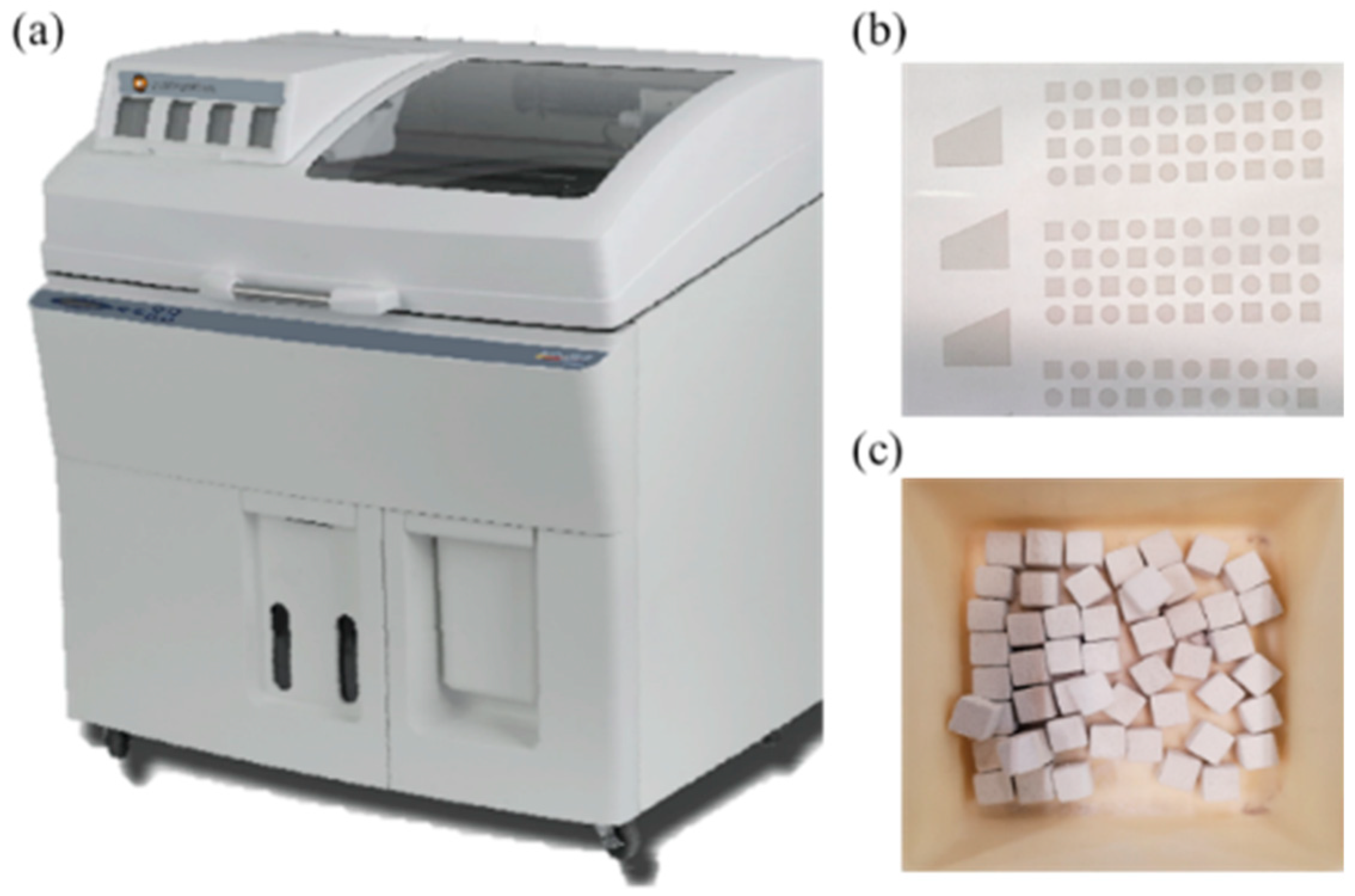
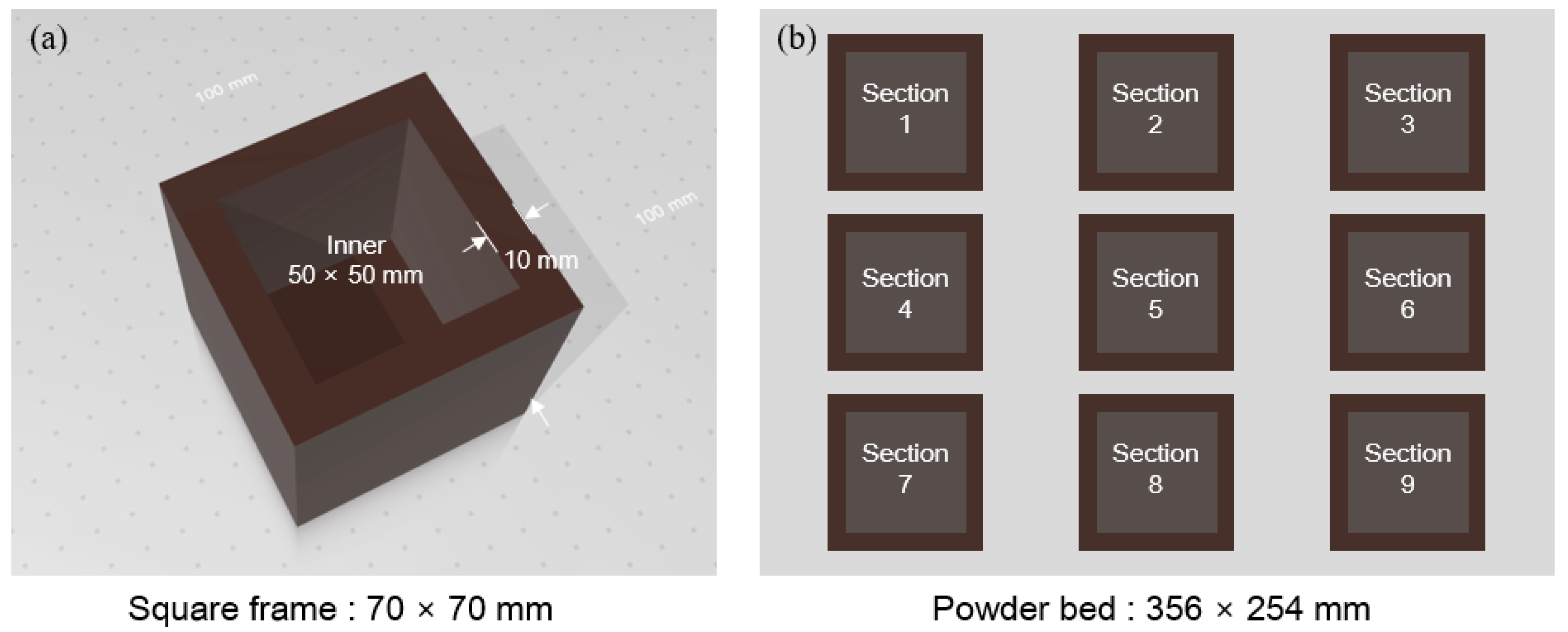
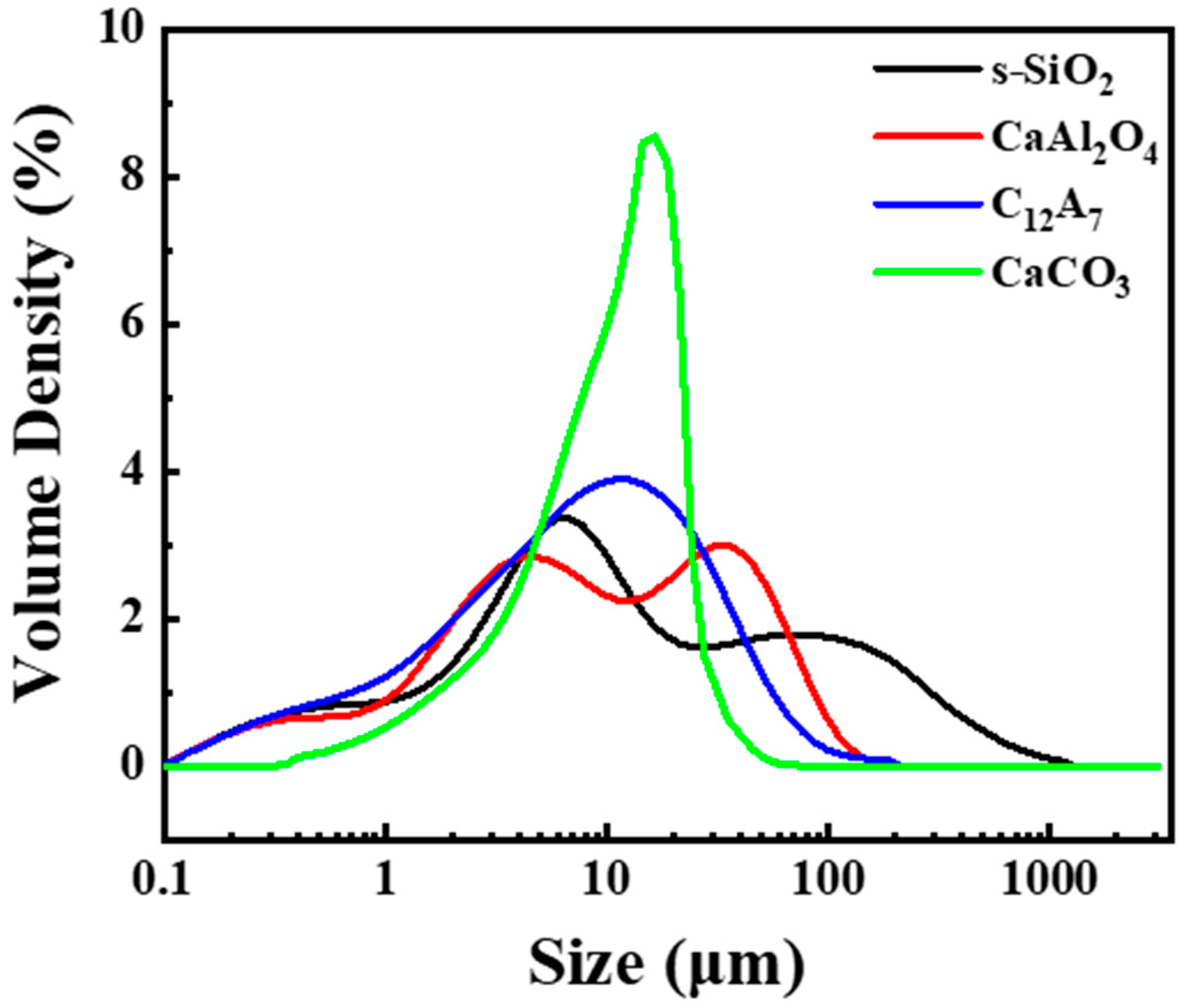


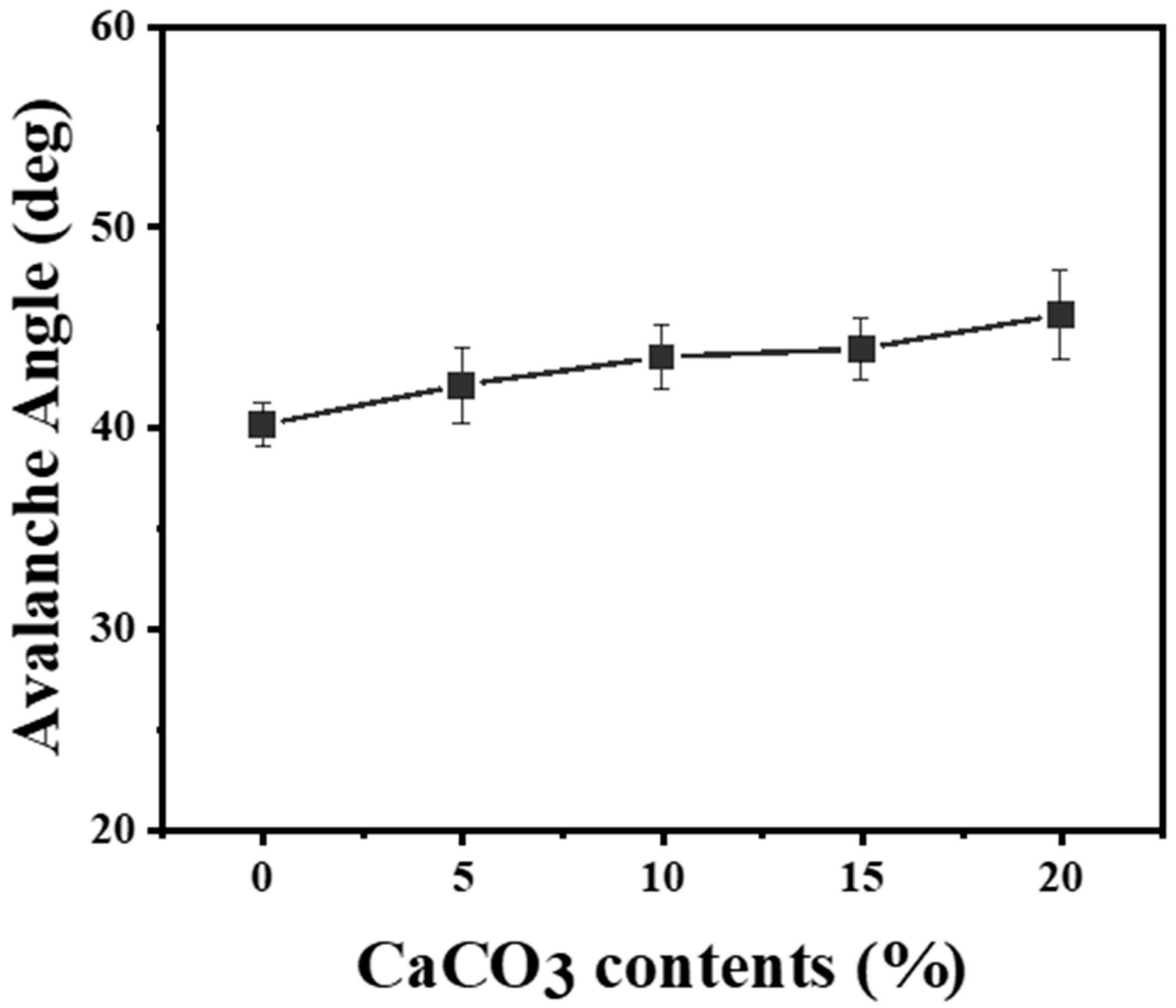
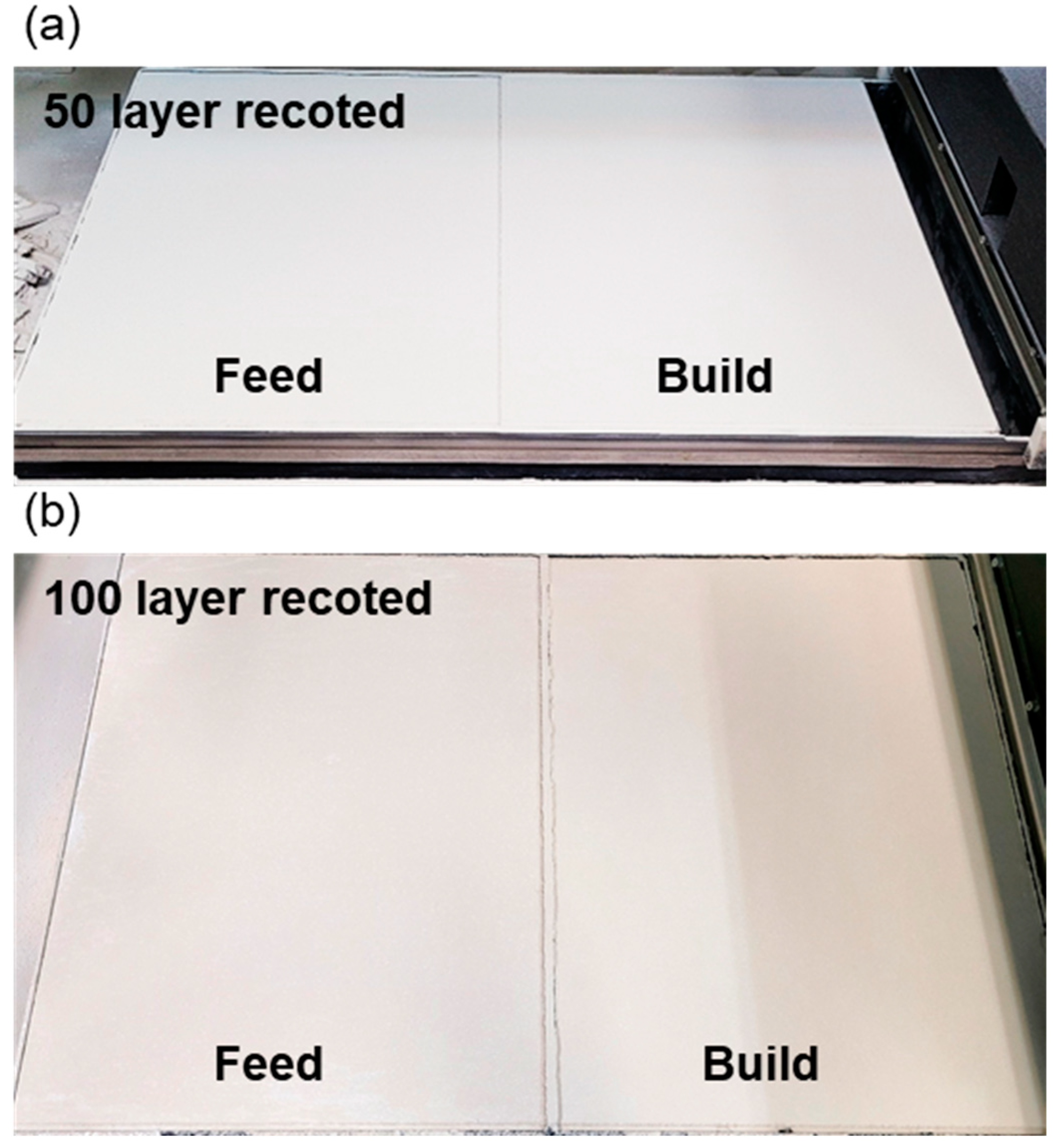
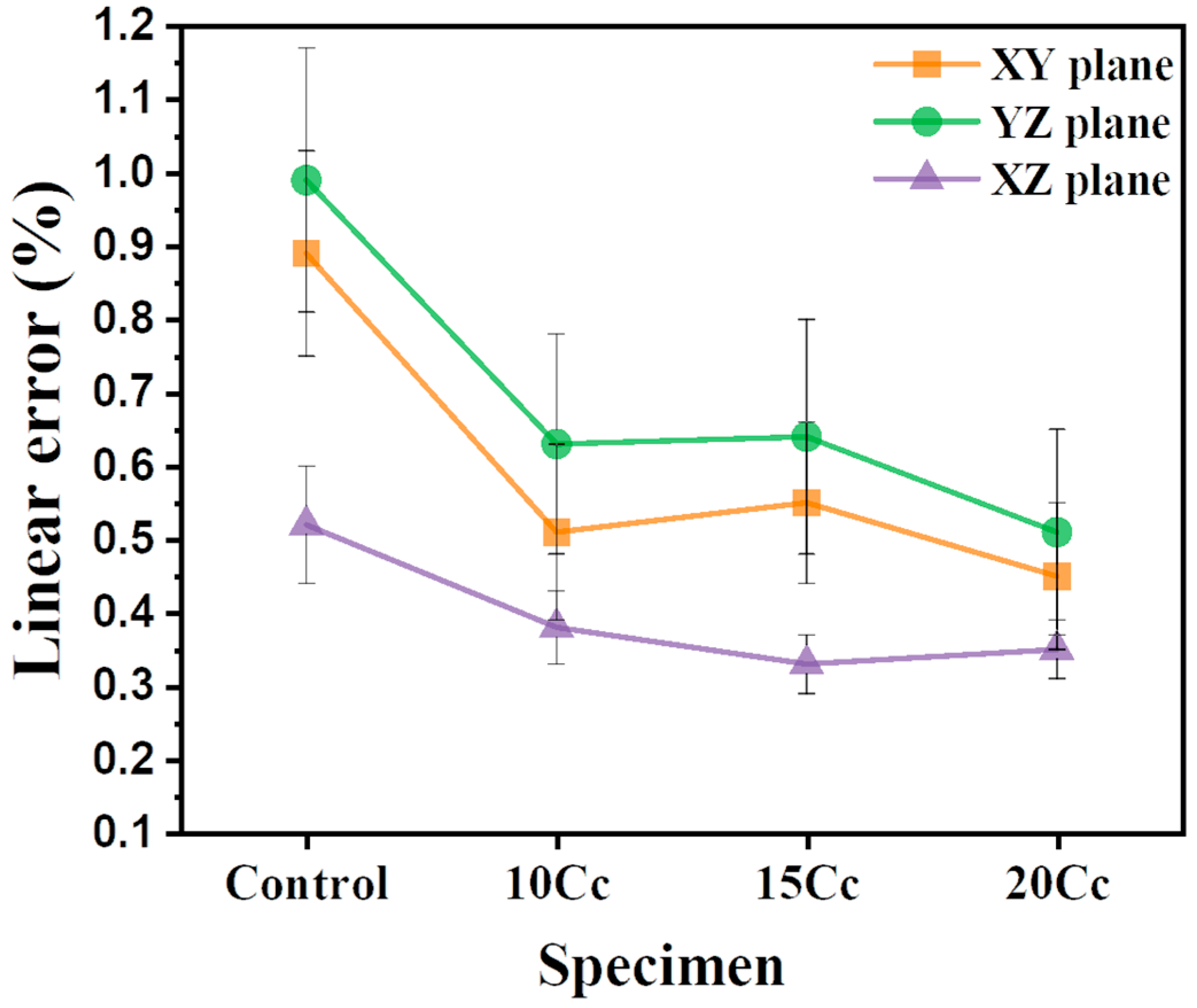
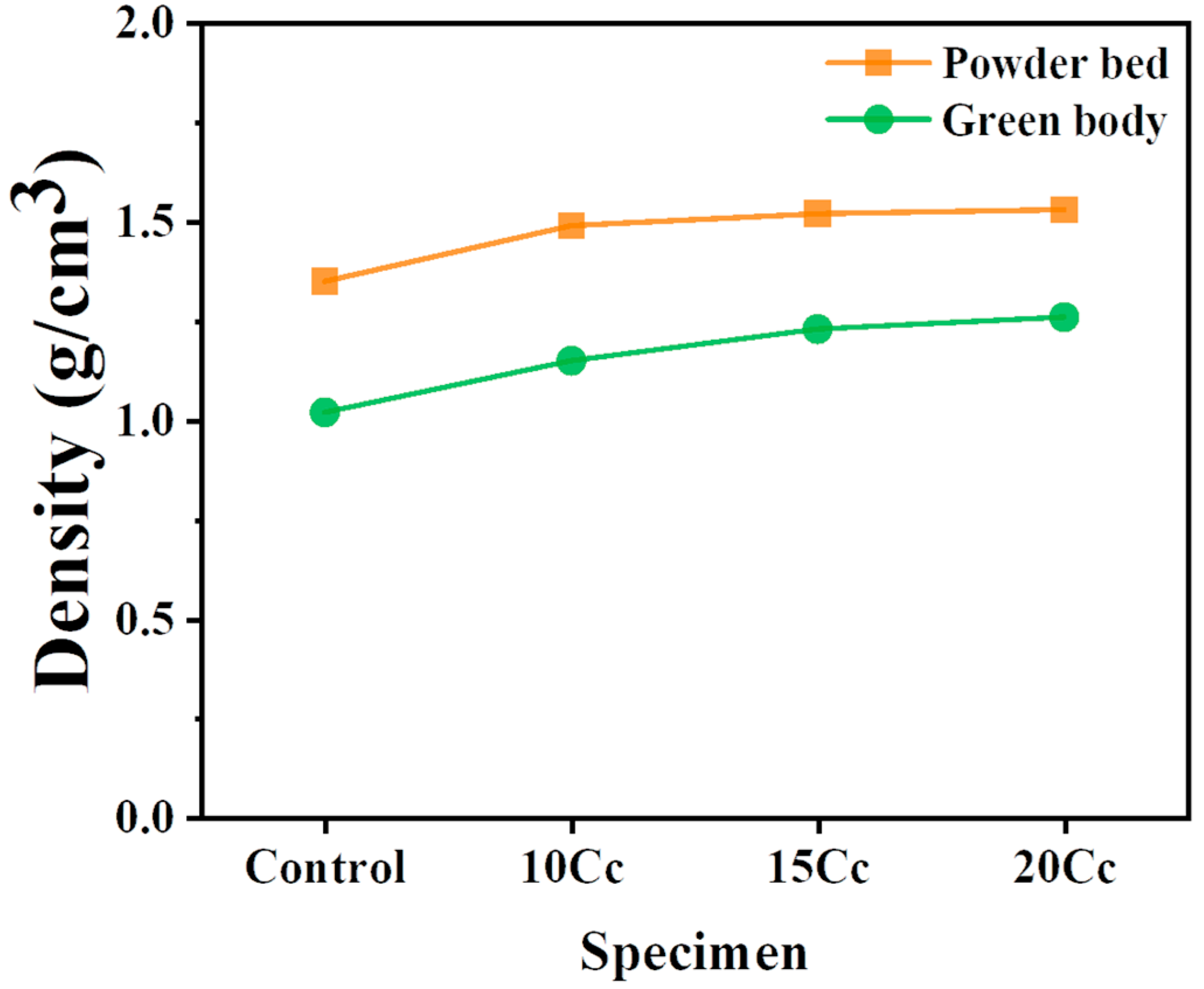

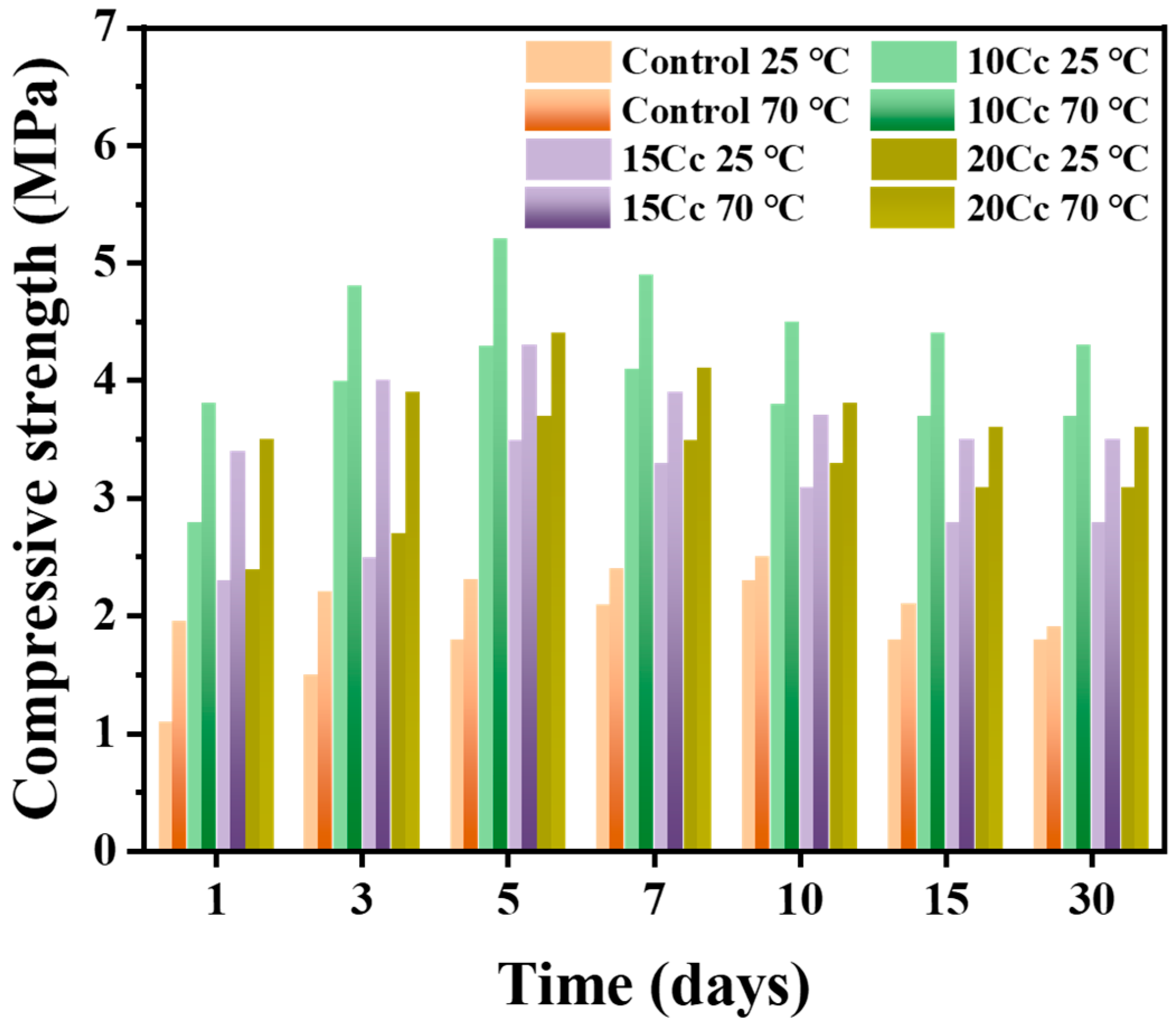
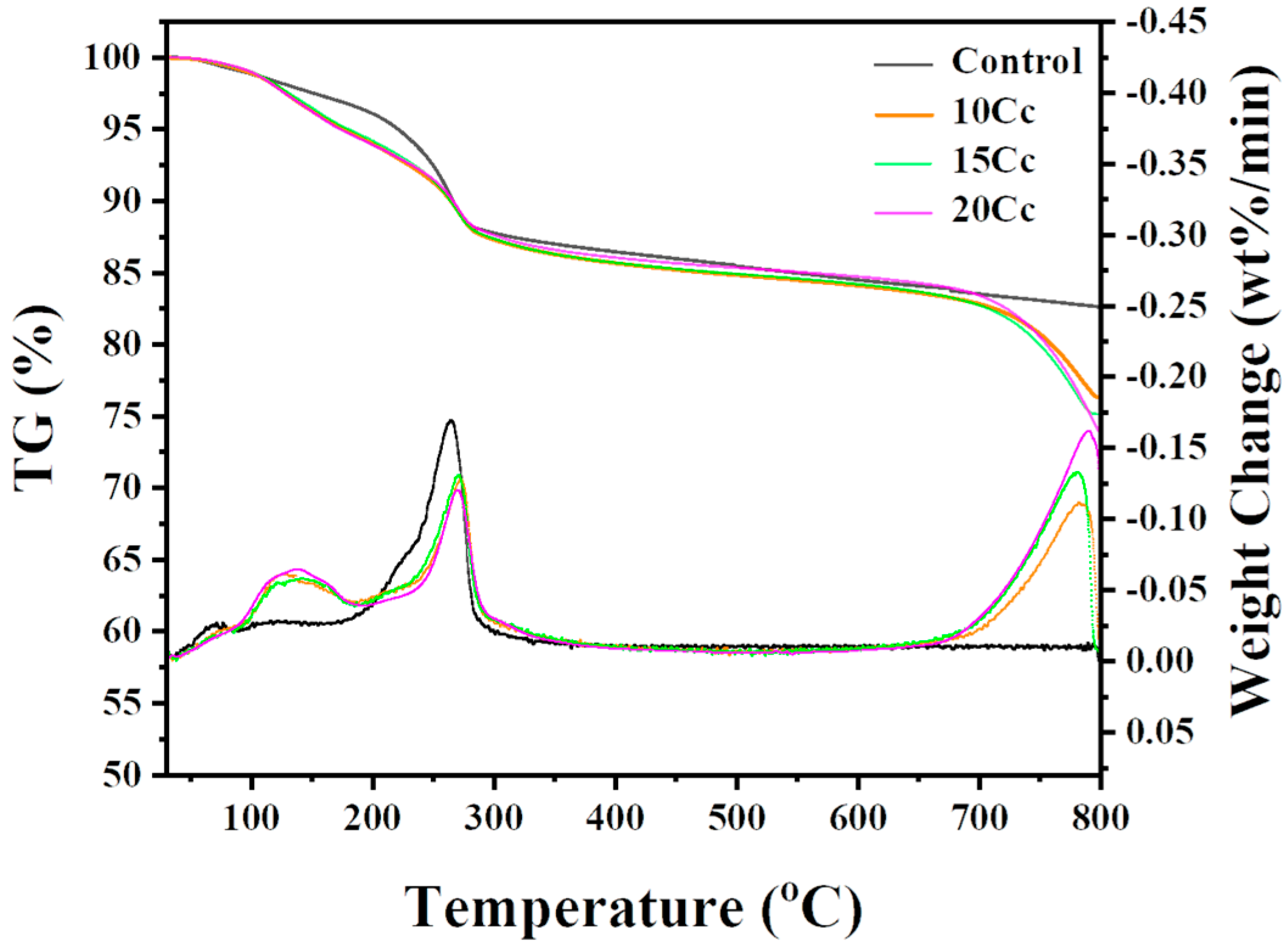
| Specimen | s-SiO2 (wt.%) | CaCO3 (wt.%) | CaAl2O4 (wt.%) | C12A7 (wt.%) | w/c Ratio |
|---|---|---|---|---|---|
| Control | 80 | - | 16 | 4 | 0.477 |
| 10Cc | 70 | 10 | |||
| 15 Cc | 65 | 15 | |||
| 20 Cc | 60 | 20 |
| Properties | Spectrum Z510 |
|---|---|
| Printhead/Operating type | HP 11/Thermal inkjet |
| Resolution | 600 × 540 dpi |
| Build Size(W × D × H) | 254 × 356 × 203 mm3 |
| Recoating type | Roller-spreading |
| Printing speed | 100 mm/s |
| Layer thickness | 102 μm |
| Activator | 97% Di water |
| Materials | d10 (μm) | d50 (μm) | d90 (μm) |
|---|---|---|---|
| s-SiO2 | 6.33 | 31.2 | 107 |
| CaAl2O4 | 0.98 | 10.7 | 179 |
| C12A7 | 1.16 | 12.1 | 92.4 |
| CaCO3 | 1.98 | 19.3 | 38.3 |
| Section | Powder Bed Density (g/cm3) | |||
|---|---|---|---|---|
| Control | 10 Cc | 15 Cc | 20 Cc | |
| 1 | 1.31 | 1.47 | 1.50 | 1.52 |
| 2 | 1.32 | 1.45 | 1.51 | 1.53 |
| 3 | 1.35 | 1.48 | 1.50 | 1.50 |
| 4 | 1.32 | 1.46 | 1.52 | 1.49 |
| 5 | 1.35 | 1.49 | 1.52 | 1.53 |
| 6 | 1.33 | 1.49 | 1.51 | 1.51 |
| 7 | 1.31 | 1.48 | 1.50 | 1.52 |
| 8 | 1.34 | 1.46 | 1.50 | 1.53 |
| 9 | 1.32 | 1.46 | 1.49 | 1.51 |
| Avg | 1.33 | 1.47 | 1.51 | 1.52 |
| Standard deviation | 0.016 | 0.015 | 0.010 | 0.014 |
Disclaimer/Publisher’s Note: The statements, opinions and data contained in all publications are solely those of the individual author(s) and contributor(s) and not of MDPI and/or the editor(s). MDPI and/or the editor(s) disclaim responsibility for any injury to people or property resulting from any ideas, methods, instructions or products referred to in the content. |
© 2024 by the authors. Licensee MDPI, Basel, Switzerland. This article is an open access article distributed under the terms and conditions of the Creative Commons Attribution (CC BY) license (https://creativecommons.org/licenses/by/4.0/).
Share and Cite
Kim, T.-H.; Ye, B.; Jeong, B.; Lee, M.-J.; Song, A.; Cho, I.; Lee, H.; Kim, H.-D. Influence of CaCO3 on Density and Compressive Strength of Calcium Aluminate Cement-Based Cementitious Materials in Binder Jetting. Materials 2024, 17, 3463. https://doi.org/10.3390/ma17143463
Kim T-H, Ye B, Jeong B, Lee M-J, Song A, Cho I, Lee H, Kim H-D. Influence of CaCO3 on Density and Compressive Strength of Calcium Aluminate Cement-Based Cementitious Materials in Binder Jetting. Materials. 2024; 17(14):3463. https://doi.org/10.3390/ma17143463
Chicago/Turabian StyleKim, Tae-Hyung, Bora Ye, Bora Jeong, Myeung-Jin Lee, Aran Song, Inkyung Cho, Heesoo Lee, and Hong-Dae Kim. 2024. "Influence of CaCO3 on Density and Compressive Strength of Calcium Aluminate Cement-Based Cementitious Materials in Binder Jetting" Materials 17, no. 14: 3463. https://doi.org/10.3390/ma17143463






